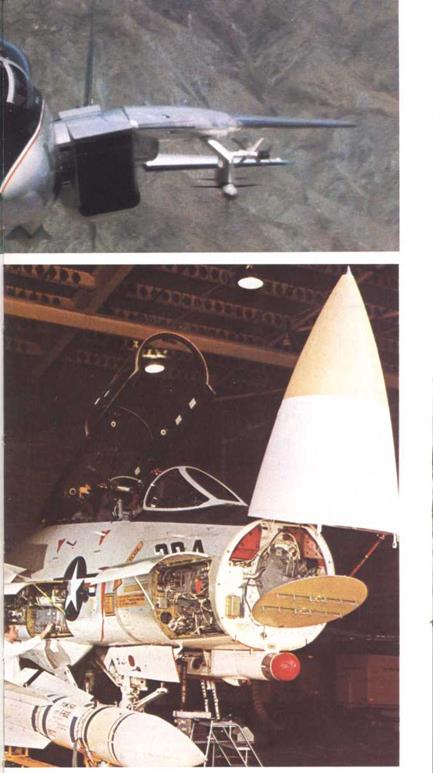F-14A, В and C
Origin: Grumman Aerospace, USA.
Type: Two-seat carrier-based multi-role fighter.
Engines: (F-14A) two 20,900lb (9480kg) thrust Pratt & Whitney TF30- 412A two-shaft afterburning turbofans: (B and C) two 28,090lb (12,741 kg) thrust Pratt & Whitney F401-400 two-shaft afterburning turbofans. Dimensions: Span (68° sweep) 38ft 2in (11 -63m), (20° sweep) 64ft 1 Jin (19-54m); length 61ft 2in (18-89m): height 16ft (4-88m).
Weights: Empty 37,500lb (17,010kg); loaded (fighter mission) 55,000lb (24,948kg), (maximum) 72,000lb (32,658kg).
Performance: Maximum speed, 1,564mph (2517km/h, Mach 2-34) at height, 910mph (1470km/h, Mach 1-2) at sea level: initial climb at normal gross weight, over 30,000ft (9144m)/min; service ceiling over 56,000ft (17,070m); range (fighter with external fuel) about 2,000 miles (3200km). Armament: One 20mm M61-A1 multi-barrel cannon in fuselage; four AIM-7 Sparrow and four or eight AIM-9 Sidewinder air-to-air missiles, or up to six AIM-54 Phoenix and two AIM-9; maximum external weapon load in surface attack role 14,5001b (6577kg).
History: First flight 21 December 1970; initial deployment with US Navy carriers October 1972; first flight of F-14B 12 September 1973.
Users: Iran (available for sale), USA (Navy, Marine Corps).
 |
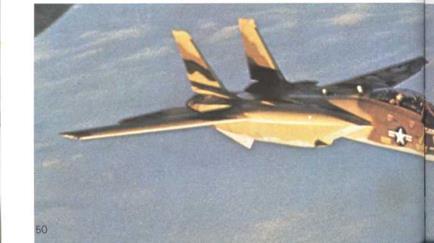 |
Development: When Congress finally halted development of the compromised F-111B version of the TFX in mid-1968 Grumman was already well advanced with the project design of a replacement. After a competition for the VFX requirement Grumman was awarded a contract for the F-14 in January 1 969. The company had to produce a detailed mock-up by May and build 12 development aircraft. Despite sudden loss of the first aircraft on its second flight, due to total hydraulic failure, the programme has been a complete technical success and produced one of the world’s outstanding
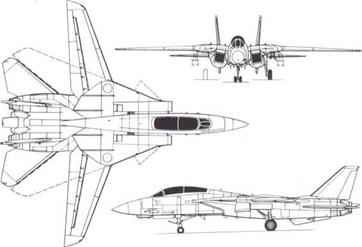 |
Above: Three-view of an F-14A showing (broken lines) range of wing and glove movement.
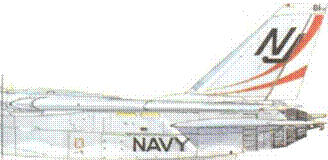
combat aircraft. Basic features include use of a variable-sweep wing, to match the aircraft to the conflicting needs of carrier compatability, dogfighting and attack on surface targets at low level: pilot and naval flight officer (observer) in tandem: an extremely advanced airframe, with tailplane skins of ►
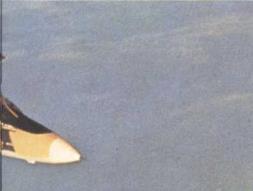 Left: In US markings but customer’s camouflage, this F-14A was one of a batch of 80 bought by Iran and delivered before the Shah went into exile in early 1979. Since then the entire force has been non – operational, and has been announced as up for sale. The US government doubts that security of its advanced radar and missile system can have been preserved.
Left: In US markings but customer’s camouflage, this F-14A was one of a batch of 80 bought by Iran and delivered before the Shah went into exile in early 1979. Since then the entire force has been non – operational, and has been announced as up for sale. The US government doubts that security of its advanced radar and missile system can have been preserved.
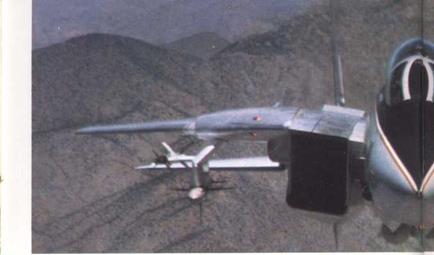
Above: Menacing aspect of an F-14A of US Navy crack fighter squadron VF-211, showing all three missile types on board.
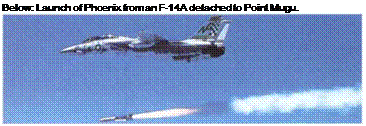 |
Right: F-14A with everything revealed, including the AWG-9 flat – plate antenna and (foreground) the long-range Phoenix AAM.
![]() boron-epoxy composite and similar novel construction methods, and one canted vertical tail above each engine; and the extremely powerful Hughes AWG-9 radar which, used in conjunction with the Phoenix missile (carried by no other combat aircraft), can pick out and destroy a chosen aircraft from a formation at a distance of 100 miles. For close-in fighting the gun is used in conjunction with snap-shoot missiles, with the tremendous advantage that, as a launch platform, the Tomcat is unsurpassed (Grumman claim it to be unrivalled, and to be able — by automatic variation of wing sweep — to outmanoeuvre all previous combat aircraft). Introduction to the US Navy has been smooth and enthusiastic, with VF-1 and -2 serving aboard Enterprise in 1974. The export appeal of the F-14 is obvious and Iran is introducing 80 from 1976. But costs have run well beyond prediction. Grumman refusing at one time to continue the programme and claiming its existing contracts would result in a loss of $105 million. For the same reason the re-engined F-14B has been confined to two re-engined А-models, and the F-14C with new avionics and weapons remains a paper project. In 1 975 production agreements were worked out and by 1977 total deliveries amounted to 243 aircraft, including about 12 for Iran. The US Navy (which includes the aircraft for the Marines) has funds for 306 F-14As and plans to buy 403 by 1981, but the requirement for an eventual total of over 500 is likely to be cut back as the F-18 comes into production. In 1976 severe trouble hit the F-14, affecting engines, fuselage structure, computer/weapon system and accidents attributed to pilot error. Efforts are being made to improve the operational-readiness rate and, if possible, increase installed engine. thrust.
boron-epoxy composite and similar novel construction methods, and one canted vertical tail above each engine; and the extremely powerful Hughes AWG-9 radar which, used in conjunction with the Phoenix missile (carried by no other combat aircraft), can pick out and destroy a chosen aircraft from a formation at a distance of 100 miles. For close-in fighting the gun is used in conjunction with snap-shoot missiles, with the tremendous advantage that, as a launch platform, the Tomcat is unsurpassed (Grumman claim it to be unrivalled, and to be able — by automatic variation of wing sweep — to outmanoeuvre all previous combat aircraft). Introduction to the US Navy has been smooth and enthusiastic, with VF-1 and -2 serving aboard Enterprise in 1974. The export appeal of the F-14 is obvious and Iran is introducing 80 from 1976. But costs have run well beyond prediction. Grumman refusing at one time to continue the programme and claiming its existing contracts would result in a loss of $105 million. For the same reason the re-engined F-14B has been confined to two re-engined А-models, and the F-14C with new avionics and weapons remains a paper project. In 1 975 production agreements were worked out and by 1977 total deliveries amounted to 243 aircraft, including about 12 for Iran. The US Navy (which includes the aircraft for the Marines) has funds for 306 F-14As and plans to buy 403 by 1981, but the requirement for an eventual total of over 500 is likely to be cut back as the F-18 comes into production. In 1976 severe trouble hit the F-14, affecting engines, fuselage structure, computer/weapon system and accidents attributed to pilot error. Efforts are being made to improve the operational-readiness rate and, if possible, increase installed engine. thrust.
|
|











